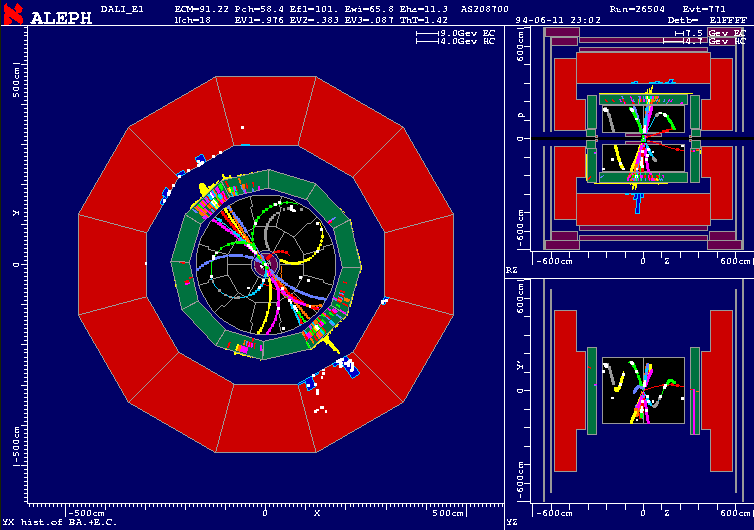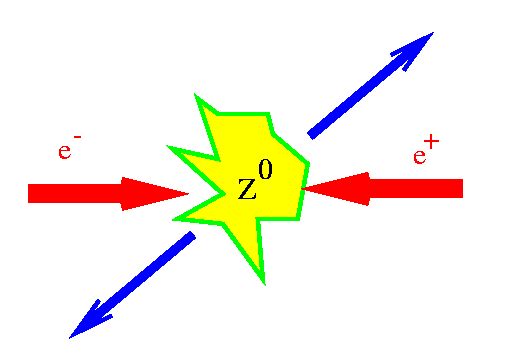

LEP is an accelerator used to produce the Z0 particle, the electrically neutral carrier of the weak force. The ALEPH detector is one of four detectors used to study the decay of this particle. The Z0 can decay into leptons or hadrons. Leptons are fundamental particles with no internal structure and include the electron, the muon and the tau as well as the electron neutrino, the muon neutrino and the tau neutrino. These decays of the Z0 are characterized by the fact that one usually sees only two particles. Hadrons are particles containing quarks and decays of the Z0 into hadrons are characterized by many particles.
 Introduction
Introduction The Elementary Particles
The Elementary Particles The Forces of Nature
The Forces of Nature LEP: The Z0 Factory
LEP: The Z0 Factory  ALEPH: A Z0 Detector
ALEPH: A Z0 Detector  ALEPH: Videos of the Detector Construction
ALEPH: Videos of the Detector Construction  Recognizing Z0 decays to electron/positron pairs
Recognizing Z0 decays to electron/positron pairs  Recognizing Z0 decays to muon/anti-muon pairs
Recognizing Z0 decays to muon/anti-muon pairs  Recognizing Z0 decays to tau/anti-tau pairs
Recognizing Z0 decays to tau/anti-tau pairs  Recognizing Z0 decays to hadrons
Recognizing Z0 decays to hadrons A simple example of the kind of collisions studied at LEP is shown here:
![[ee to mu mu]](/~stdenis/eetomumu.gif)
This picture shows the annihilation of an electron (e-) and a positron (e+). A positron is the antimatter equivalent (or antiparticle) of an electron. The electron and positron fly towards one another at high energy. They collide to produce a Z0 particle. Because the initial e- and e+ have momenta which are opposite in direction and equal in magnitude the Z0 has no net momentum and is, therefore, stationary. After a very short time (about 10-24 seconds) the Z0 decays to produce, for example, a muon (µ-) and an antimuon (µ+). The muon and antimuon then fly apart "back to back" with one another.
We surround the place where the Z0 is produced with
detectors, which enable us to "see" the particles produced when it decays.
The first group we call the "leptons":
![[leptons]](/~stdenis/leptons.gif)
In addition to the electron and muon that we have met already, a third member
of this group also carries an electric charge; this particle is
called the "tau".
Each of these three particles has a partner called a "neutrino".
Neutrinos carry no electric charge and can travel large distances through
matter without interacting.
They leave no tracks in our detector although sometimes we can deduce that a
neutrino was produced.
(You'll see how later on!)
![[quarks]](/~stdenis/quarks.gif)
The "up" and the "down" quark can be found inside protons and neutrons
(which themselves can be found inside atomic nuclei).
The more massive quarks can be made at particle accelerators or by the
interactions of cosmic rays in the upper atmosphere,
but don't occur naturally on earth.
The quarks and leptons appear in three generations, indicated by the brown, yellow and pink colours. It is a mystery why these three generations exist. The particles within a generation have identical properties (forces they experience and their charges) except for one very important one, their masses. Nonetheless, one of the most important measurements at LEP has been to show that there are indeed three generations of quarks and leptons.
It would be a very boring universe indeed, if the above particles did not experience forces. The present picture of how this happens is called the "Standard Model" in which the particles are described as interacting by exchanging other particles. The best way to think about this is to consider the following analogy sketched here.
![[skaters]](/~stdenis/skaters.gif)
Two people are roller blading
along, side by side, with one carrying a ball. At some point, the one with
the ball, throws the ball to the other person.
The person throwing the ball is deflected off his original course. The one
receiving the ball is also thrown off of her course. By this exchange, the
two people communicate with one another.
![[more skaters]](/~stdenis/skaters_top.gif)
Two electrons experience mutual electric forces on each other
by exchanging a particle called a photon. This is drawn as follows:
![[electrons exchanging photon]](/~stdenis/electron_scat.gif)

![[bosons]](/~stdenis/bosons.gif) The photon is in fact a particle of light and it carries the
electromagnetic force. There are three other forces in nature.
First, there is the weak nuclear force that causes radioactive decay. There
are three particles carrying this force, the W+,W-,
and the one produced in LEP, the Z0. The second force is the
strong nuclear force.
When applied to up and down quarks this holds them together to
make neutrons and protons which in turn stick together to make the nucleus
of atoms. There are eight particles used to convey this force and
they are called gluons. The final force is the familiar force of gravity
and the particle exchanged there is the gravitino.
The photon is in fact a particle of light and it carries the
electromagnetic force. There are three other forces in nature.
First, there is the weak nuclear force that causes radioactive decay. There
are three particles carrying this force, the W+,W-,
and the one produced in LEP, the Z0. The second force is the
strong nuclear force.
When applied to up and down quarks this holds them together to
make neutrons and protons which in turn stick together to make the nucleus
of atoms. There are eight particles used to convey this force and
they are called gluons. The final force is the familiar force of gravity
and the particle exchanged there is the gravitino.
In fact, this is not entirely the end of the story! In recent years, it has been shown that at the beginning of the universe, very shortly after the Big Bang, the electromagnetic force and the weak nuclear force were manifestations of the same force, now called the electroweak force. It is this unification of forces that is investigated in the LEP accelerator with experiments such as ALEPH. With LEP it is possible to create the conditions of the universe shortly after the Big Bang. Measurement with data from this experiment gives experimental proof that the theory that unites these forces works and is what you will participate in analyzing today!
...But the story goes on. There is much work to try to understand how
to unite the other forces of nature with the Electroweak force! The
theories that describe this unification are called Grand Unified
Theories, or GUT's for short. These theories have not been experimentally
proven. It will be up to you to design the theories and the experiments to
do this! But not today. Tomorrow?
![[e e to mu mu feynmann]](/~stdenis/eetomumu_fey.gif)

![[picture of aleph]](/~stdenis/aleph1.gif)
Beams of electrons and positrons enter the detector as shown by the arrows. They collide, creating Z0's in the middle of the detector. As stated, the Z0's decay almost instantly (10-24 seconds) and the leptons or hadrons into which they decay travel through the detector.
![[cross section of aleph]](/~stdenis/aleph.gif)
A cross-sectional cut through the detector shows the concentric cylinders of different types of detectors encountered by particles coming from the Z0 decay. A particle which is produced at the center of the ALEPH detector begins its journey by travelling through three detectors (VDET, ITC, TPC) which track its progress through a magnetic field produced by the coil (in blue). However, these elements can only detect electrically charged particles. By measuring the tracks of the particles in the magnetic field, it is possible to measure their momenta. The particles then strike a detector composed of a many-layered sandwich of lead and tubes that operate much like Geiger tubes. If the particles produced are electrons or positrons, then they will stop in these lead sandwiches and deposit all of their energy. (This is also true for photons.) Since the instrument measures energy, it is called a calorimeter and, more specifically, because it measures the energy of electons it is called an electromagnetic calorimeter, or ECAL for short.
Particles surviving the trip thus far continue into the portion of the detector indicated in orange in the diagram of the detector. This part consists of a sandwich of steel and tubes that operate much like Geiger tubes. Hadrons, which are particles composed of quarks, will make the trip this far, but then they deposit all of their energy here. Thus, this is called a hadron calorimeter, or HCAL for short. (They can also leave a bit of energy behind in the ECAL, so one has to look at both detectors to measure the energies of these particles).
Particles that still survive the trip beyond HCAL are muons and they will leave a track in the hadron calorimeter as well as go on to the muon chambers, two layers of Geiger-like tubes that surround the rest of ALEPH.
Photons or particles of light will not leave any tracks in the first three detectors (VDET, ITC, TPC) but will deposit all of their energy in the electromagentic calorimeter. Neutrinos will not interact with any of the detectors and leave the experiment without a trace. However, since they carry energy away, one notices that the total detected energy is less than the total energy in both beams and this "missing" energy can be used as an indication that a neutrino was produced.
The construction of the ALEPH detector may be viewed using QuickTime.
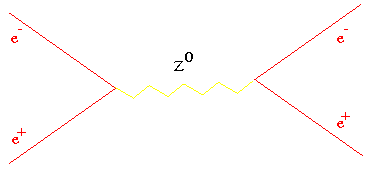
The picture above of the production and decay of a Z0 can be drawn for the case that a Z0 decays into an electron/positron pair. The schematic picture for this is:
Since electrons and positrons are charged particles
they will leave tracks in the
first parts of the detector,
stop in the electromagnetic calorimeter,
and not appear at all in the HCAL or the muon
chambers. The diagram above shows that only one pair of particles is produced
so that one expects only two tracks. An event of this type is shown here.
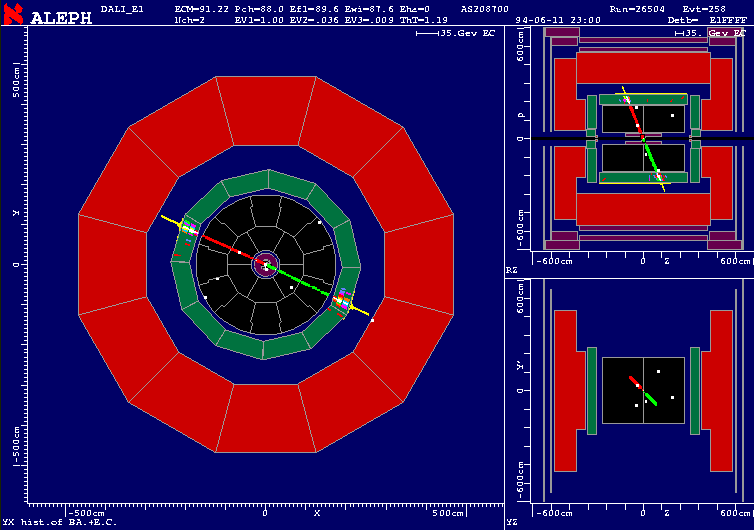
The tracks are indicated by the series of red and green dots on a black background in the middle of the picture. The smaller pictures on the right show the same event viewed from the side and top of ALEPH. There is activity where the tracks point to in the green portion of the picture depicting the electromagnetic calorimeter. The small yellow bars on top of the green portion are small charts of the energy spread in the detectors: one sees that the energy is very concentrated along the line of the track. Also, there is no energy in the hadron calorimeter (red) or the muon chambers (only shown if there is something to show.).
At the top of the display are some numbers. ECM is the center of mass energy or the sum of the energies of the electron and positron beams. This is seen to be 91.22 GeV. Pch is the total of all the energy measured in the tracks. This is very close to the beam energy, 88.0 GeV. Ewi is the energy detected in the ECAL alone and Eha is that in the HCAL alone. It is seen that the Ewi energy is about the same as the beam energy and the Eha energy is zero. The final number of interest is on the next line, Nch=2. This is the number of charged tracks and it is exactly two. These numbers are characteristic of the decay of a Z0 into electrons and positrons: two particles with a momentum that is matched to the energy they deposit only in the electromagnetic calorimeter. This energy is in turn matched well with the original energy in the incoming beams.
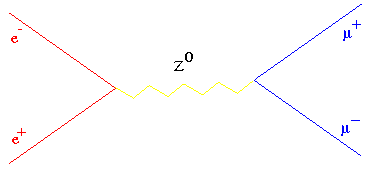
The picture above of the production and decay of a Z0 can be drawn for the case that a Z0 decays into an muon/anti-muon pair. The schematic picture for this has been shown before:
Muons and antimuons are also charged particles so they
will leave tracks in the
first parts of the detector; however, unlike the electrons and positrons,
they are not stopped by the ECAL nor by the HCAL and will leave tracks
in the muon chambers.
The diagram above shows that only one pair of particles is produced
so that one expects only two tracks. An event of this type is shown here.
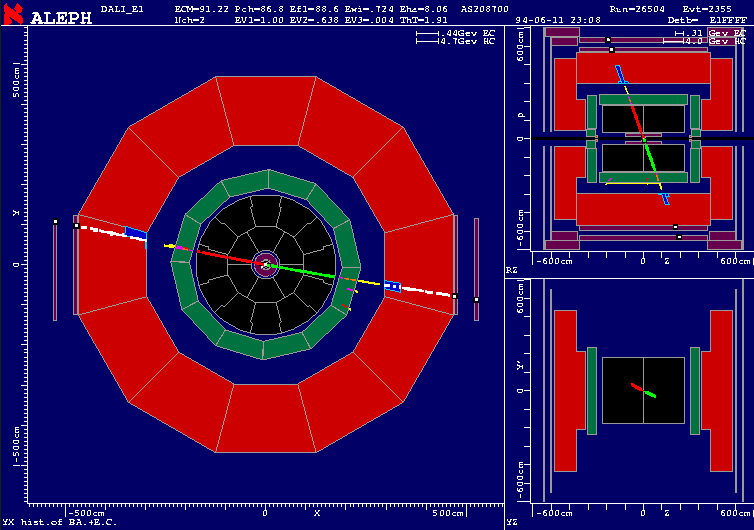
As for the electron/positron pair, the tracks are indicated by the series of red and green dots on a black background in the middle of the picture. However, this time, the tracks appear to go right through both the ECAL and HCAL and there are tracks in the muon chambers as well.
Looking at the numbers at the top of the picture, Pch, the energy in the tracks, is close to the beam energy, as for the electrons. However this time, the energy in the ECAL (Ewi) is very tiny, 0.7 GeV and that in the HCAL is also relatively small, only 8.06 GeV. This is characteristic of a Z0 decay into an muon/anti-muon pair: two particles whose momentum sum matches the beam energy rather closely and both of which pass through the rest of the detectors depositing relatively little energy in the ECAL and HCAL and leaving tracks in the muon chambers.
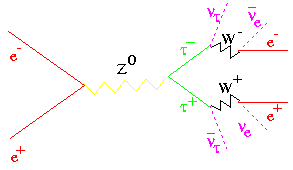
The picture for the case that a Z0 decays into an tau/anti-tau
pair is a complicated by the fact that the tau itself decays into a tau
neutrino and the
charged carrier of the weak force, the W+ or W-.
The W particle decays into quarks or into two leptons, one of which is a neutrino.
An example of this is shown here for the case where both taus decay into electrons.
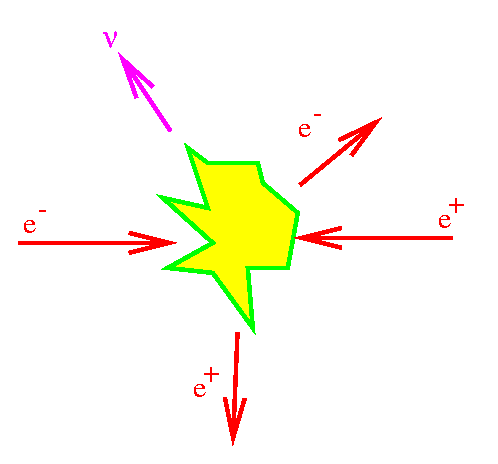 This looks quite complicated, but if one just studies what is coming out of the
center of the detector, lumping all the neutrinos into one missing energy
arrow, it looks more like:
This looks quite complicated, but if one just studies what is coming out of the
center of the detector, lumping all the neutrinos into one missing energy
arrow, it looks more like:
Other possible combinations are: electron/muon, electron/hadron, muon/muon, muon/hadron, hadron/hadron and are illustrated here:
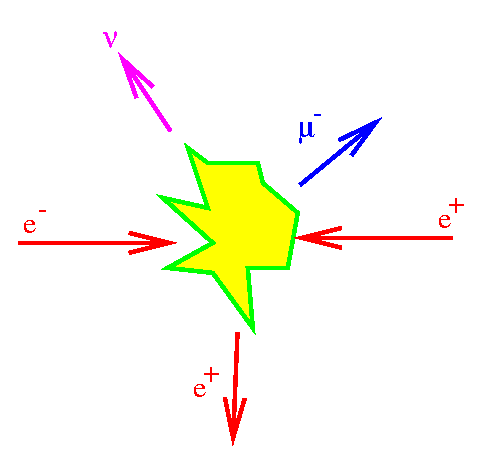
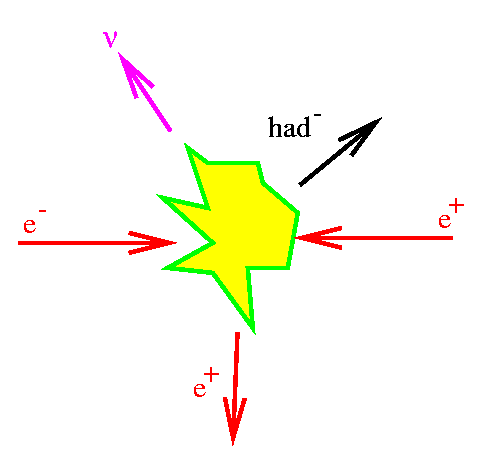
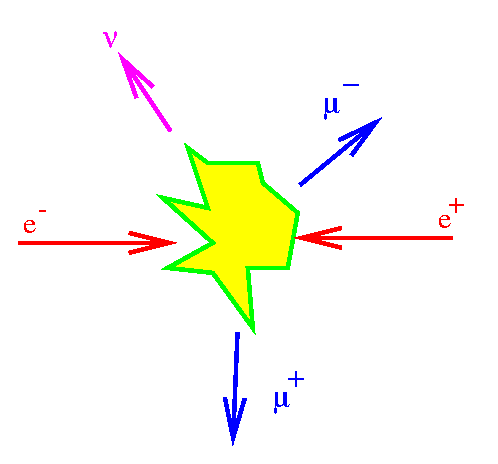
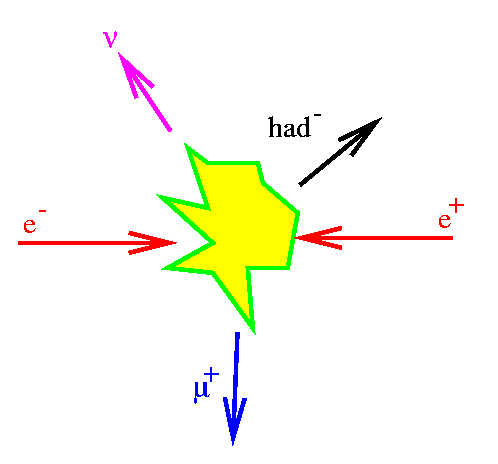
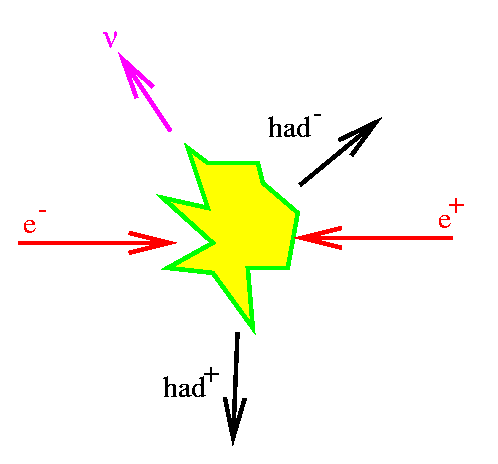
Therefore, the final particle configurations always have some missing energy because of the tau neutrino which escapes detection. Each of the two taus will decay as they wish. The neutrinos in the leptonic decays lead to even more missing energy: this is what distinguishes them from the decays of the Z0 to electrons and muons directly. So while the events are more complicated than the first two cases, they can be identified. An event with an electron and a muon is shown here:
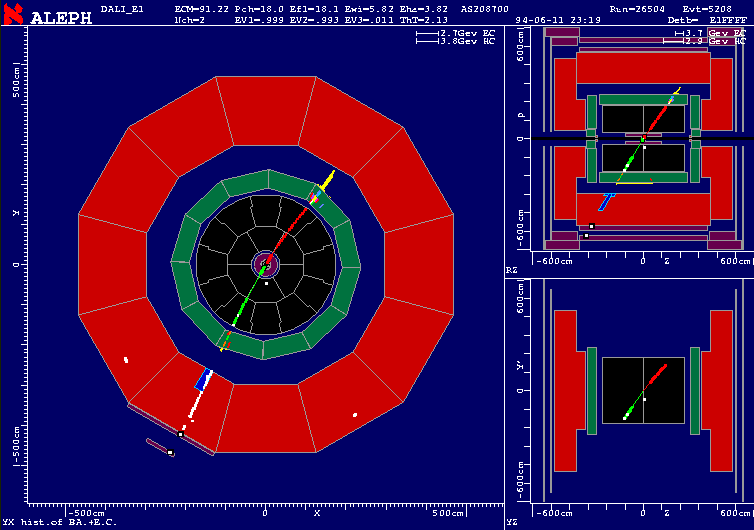
This time the electromagnetic calorimeter has little energy (Ewi=5.82) because so much energy is lost in the neutrinos. The muon on the other side penetrates the hadron calorimeter leaving very little energy there as well. The total energy in tracks is only Pch=18.0 GeV. The number of charged tracks is still 2 as expected. Therefore the event is quite different from the decays of the Z0 into two muons or two electrons both in the fact that there are two different particles in one event and also that the total energy in tracks is so small.
